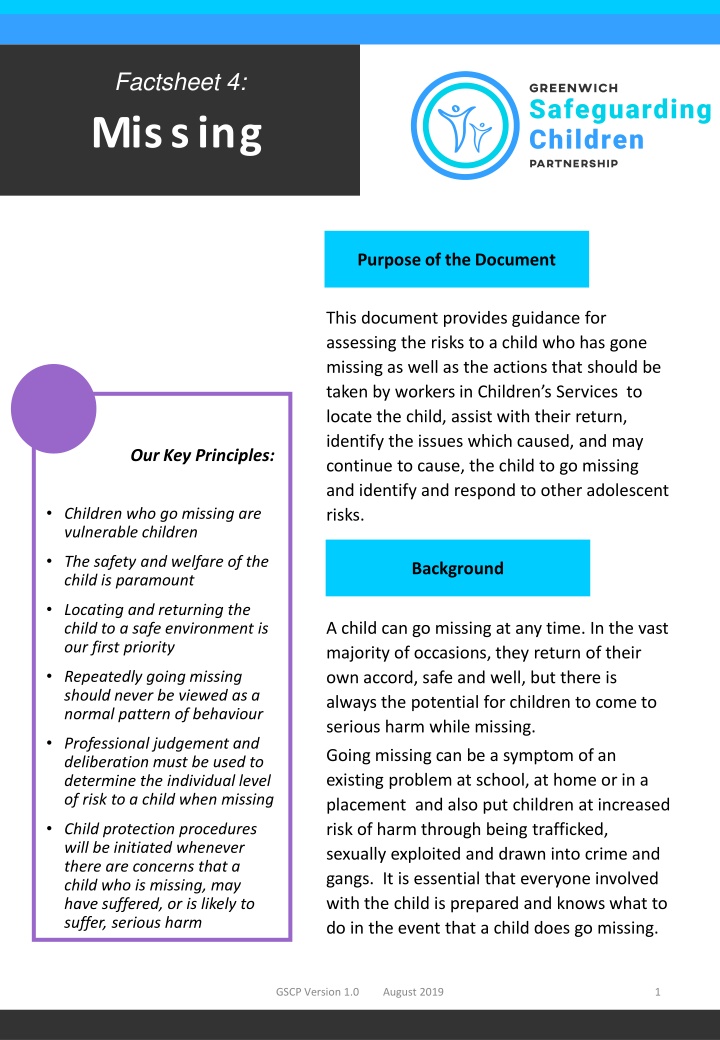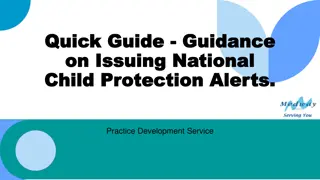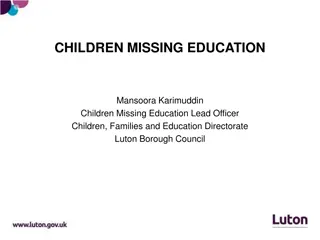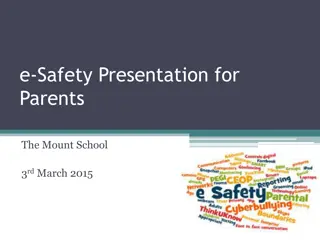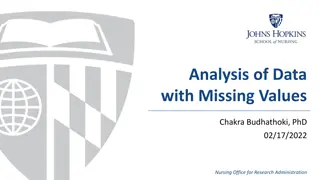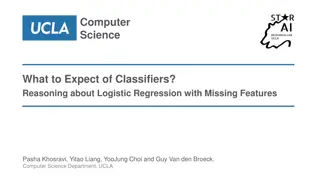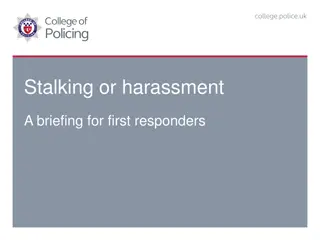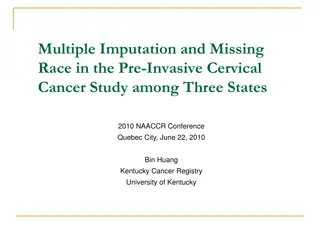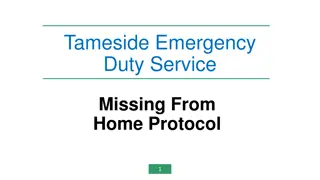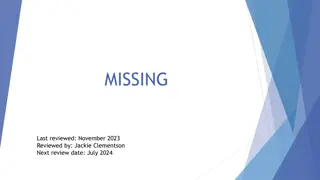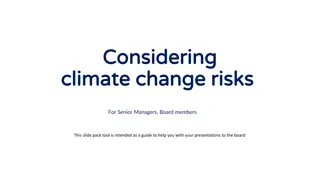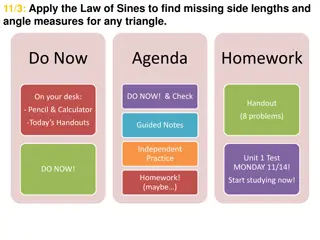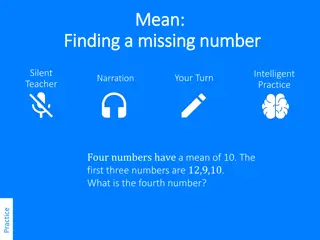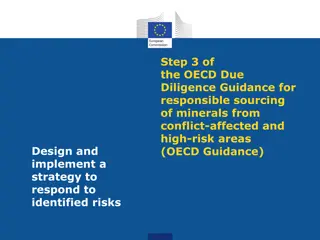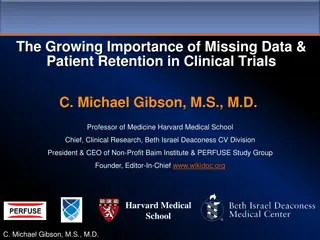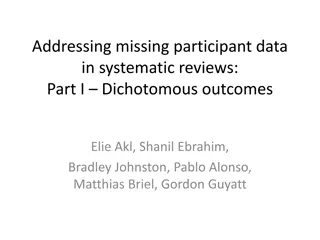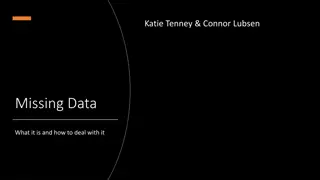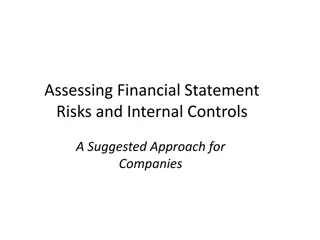Guidance for Assessing Risks to Missing Children
This document offers guidance on assessing risks to missing children and outlines actions to be taken by Children's Services workers. It emphasizes the importance of promptly locating and ensuring the safety of missing children, addressing underlying issues, and responding to potential risks. The document underscores the vulnerability of missing children and the paramount importance of their safety and welfare. Professional judgment is crucial in evaluating individual risk levels and initiating child protection procedures when necessary.
Download Presentation

Please find below an Image/Link to download the presentation.
The content on the website is provided AS IS for your information and personal use only. It may not be sold, licensed, or shared on other websites without obtaining consent from the author.If you encounter any issues during the download, it is possible that the publisher has removed the file from their server.
You are allowed to download the files provided on this website for personal or commercial use, subject to the condition that they are used lawfully. All files are the property of their respective owners.
The content on the website is provided AS IS for your information and personal use only. It may not be sold, licensed, or shared on other websites without obtaining consent from the author.
E N D
Presentation Transcript
Factsheet 4: Missing Purpose of the Document This document provides guidance for assessing the risks to a child who has gone missing as well as the actions that should be taken by workers in Children s Services to locate the child, assist with their return, identify the issues which caused, and may continue to cause, the child to go missing and identify and respond to other adolescent risks. Our Key Principles: Children who go missing are vulnerable children The safety and welfare of the child is paramount Background Locating and returning the child to a safe environment is our first priority A child can go missing at any time. In the vast majority of occasions, they return of their own accord, safe and well, but there is always the potential for children to come to serious harm while missing. Repeatedly going missing should never be viewed as a normal pattern of behaviour Professional judgement and deliberation must be used to determine the individual level of risk to a child when missing Going missing can be a symptom of an existing problem at school, at home or in a placement and also put children at increased risk of harm through being trafficked, sexually exploited and drawn into crime and gangs. It is essential that everyone involved with the child is prepared and knows what to do in the event that a child does go missing. Child protection procedures will be initiated whenever there are concerns that a child who is missing, may have suffered, or is likely to suffer, serious harm GSCP Version 1.0 August 2019 1
Consideration should be given as to whether to present to GRASP. When a Child is Missing Workers should keep in touch with the family/carer to offer advice and support and either maintain or try to maintain contact with the child. If the information about a child going missing has not come from the police, the worker should ensure that the child has been reported to the police by the parent or carer, and if this has not been done, report it themselves. If this is a child in the care of the local authority, this should be done on a daily basis. If it is known that a different professional is more likely to get a response, this should be agreed by the professional network at the beginning of the missing episode. For practitioners outside of Children s Social Care or Early Help, a referral should be made to the allocated worker (if known) or the Front Door. The message of all contacts with the child should be clear and unambiguous: our primary concern is for the child and that there will be support when they return. If it is agreed that a professional who is not employed by RBG is the best link with the child then there should be a written note of this agreement and what form the contact will take. should be clear and unambiguous: our primary concern is for the child and there will be support when they return. The Children s Services worker should complete an immediate analysis of risk on Frameworki. If the case is unallocated and there are concerns about additional vulnerability, it should be allocated for a Child and Family Assessment. The message of all contacts to the child Consideration on both unallocated and allocated cases should be given as to whether a Section 47 Strategy meeting should be convened. Workers in Early Help should consider whether a step up is needed. GSCP Version 1.0 August 2019 2
The professional network should also agree who is best placed to do the Return Home Interview when the child has returned. information about the child s whereabouts online and all information about the child s family and social networks and the sharing of intelligence. It should be agreed what the family will be told, and how often, if the child does not usually live with family. If the missing child is a child in our care a Missing S trategy Meeting should always be held by the 10th day of missing or earlier if the child is deemed to be at high risk or vulnerable whilst they are missing. Missing S trategy Meetings should decide what actions need to be taken and by whom to ensure that the child is found as soon as possible. This could include the Police searching for Missing S trategy Meetings should be held monthly if the child is still missing and regular liaison with the key agencies and professional network should occur outside of the meeting. Missing or Absent or Unauthorised Absence - What is the Difference? A child is absent if they are not at a place where they are expected or required to be. A child is missing when their whereabouts cannot be established and where: The circumstances are out of character The context suggests the child may be subject of a crime or at risk of harm to themselves or another Unauthorised absence is when a child in our care is not at their placement or place they are expected to be and their carer knows where they are but has concerns or the incident is notified to the police. GSCP Version 1.0 August 2019 3
The child should be offered the option of speaking to an independent representative or advocate. If the child is a child in our care, the IRO should be informed. When a Child Returns Parents, carers and professionals should promptly inform the police and the rest of the professional network when a child returns or is found. The purpose of the Return Home Interview is to: Identify and deal with any harm the child has suffered including harm that might not have already been disclosed as part of the Safe and Well check' either before they ran away or while missing Understand and try to address the reasons why the child ran away Help the child feel 'safe'/understand that they have options, to prevent repeat instances of them running away Understand what the child would like to see happen next whether short term and/or long term Gather the parents or carers views of the circumstances, if appropriate Provide the child with information on how to stay safe if they choose to run away again, including helpline numbers. Once a child is found, the police may carry out a Safe and Well check. The purpose of these interviews is to check for any indications that the child has suffered harm, where and with whom they have been, and to give the child an opportunity to disclose any offending by or against them. Within 72 hours of the child being located, a Return Home Interview should be offered. This is an in-depth conversation carried out by a professional (e.g. a social worker, teacher, health professional or police officer) who is not involved in the direct care of the child. The child should be seen on their own unless they specifically request to have someone with them. Ideally this conversation should be face to face, however what is most important is that the conversation happens and so it may take place over the phone. Regardless of who completes the Return Home Interview, it is the responsibility of the worker in Children s Services to ensure that the record is loaded onto the child s electronic file. GSCP Version 1.0 August 2019 4
If Repeated Missing Episodes Occur We know from experience that the risks to the child will increase We must never treat this as normal behaviour We should review the strategy is there someone else in the professional network who the child might engage with? We will not give up. We will continue to offer return home interviews, seek advice and support and keep trying to change the situation. GSCP Version 1.0 August 2019
The Police Role in Missing Children The Metropolitan Police Service is the lead agency for investigating and finding missing children. They are responsible for making a decision, based on on- going risk assessment, of whether a child is absent or missing . If a child is recorded as absent , the police will agree review times and any on- going actions with the person reporting the absence. All children recorded by police as absent are monitored on the police. Monitoring is ongoing and subject to regular reviews to ensure risk levels do not change. Where information comes to light which introduces any risk to the child, then the case may be re- categorised as 'missing' and a police investigation instigated. All children recorded as missing are categorised by the police as medium or high risk. A missing child incident would be prioritised as 'high risk' where: The risk posed is immediate and there are substantial grounds for believing that the child is in danger through their own vulnerability or The child may have been the victim of a serious crime or The risk posed is immediate and there are substantial grounds for believing that the public is in danger. A high risk missing child requires the immediate deployment of police resources. A member of the senior management team or similar command level must be involved in the examination of initial enquiry lines and approval of appropriate staffing levels. An Investigating Officer and possibly a Senior Investigating Officer and a Police Search Advisor (PolSA) should be appointed. There should be a media strategy and/or close contact with outside agencies. Family support should be put in place. The UK Missing Persons Bureau should be notified of the case immediately. CEOP and local authority children's services should also be notified. A 'medium risk' missing child requires an active and measured response by police and other agencies in order to trace the missing person and support the person reporting. This will involve a proactive investigation and search in accordance with the circumstances. GSCP Version 1.0 August 2019 6
Missing Child: Response Children s Services Recording Activity Operational Activity Whereabouts of child unknown Missing episode created by MASH if unallocated, by worker if allocated Pass information to allocated worker, manager and Business Support Child Pass to CSC Front Door Practitioners open to CSC, EH or YOS? Manager to record in episode whether missing, absent or neither Decide if child is missing, absent, or away without authorisation With 24 hours of becoming aware If missing, ensure this has been reported to police Complete an immediate analysis of risk CFA if unallocated. Otherwise consider step up or Section 47 and/or discussion at GRASP. If unallocated, pass to EH for intervention and RHI Concerns about additional vulnerability? Keep in touch with the family/carer to offer advice, support Maintain/try to contact the child. If CIOC on a daily basis. Make/maintain contact with other professionals involved. Agree who will do Return Home Interview. Vulnerability and risk tick boxes to be completed If COIC, inform IRO and convene a Missing From Care Meeting if not found within 10 days or known high risk. GSCP Version 1.0 August 2019 7
Returned Child: Response Children s Services Recording Activity Operational Activity Allocated worker informs key professionals (notice may come from police, family, placement or another professional) Enter date child found. Check Save and close NOT Finish Allocated worker arranges for completion of Return Home Interview to by professional not involved in child s direct care,. (in most cases EH, SW or YOS) Allocated worker or their BS uploads RHI documents labelled --/--/-Name.RHI and completes the RHI monitoring screen. Click Finish. Agreed interviewer undertakes RHI, records on agreed template, sends to allocated worker Allocated worker reviews the RHI with manager, updates the risk assessment and records action to reduce risk. Business Support to run weekly reports to ensure all data is up to date and identify outstanding RHIs GSCP Version 1.0 August 2019 8
